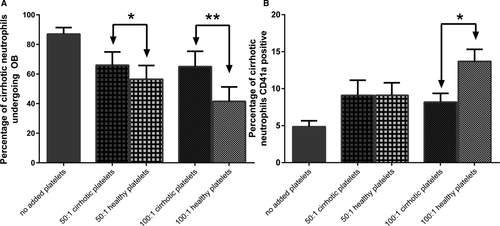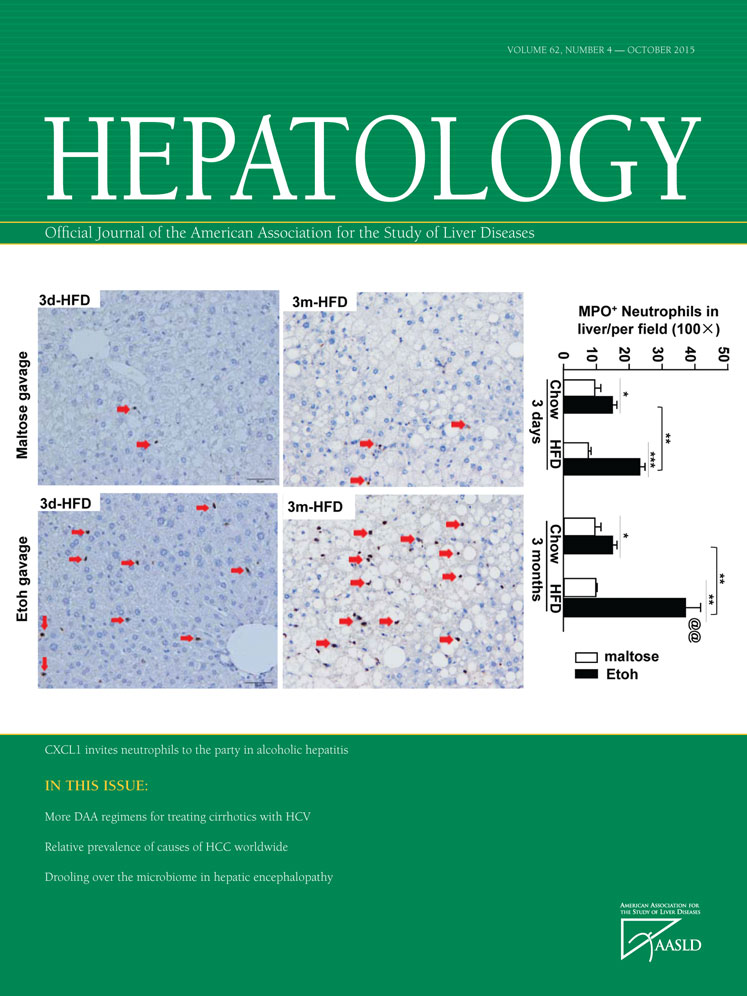Could abnormal neutrophil-platelet interactions and complex formation contribute to oxidative stress and organ failure in cirrhosis?
This pilot study was funded by the Isaac Schapera Research Trust in an award to Jonathan Sturgeon in 2012-2013.
Potential conflict of interest: Dr. Bernal consults for Vital Therapies and Ocera.
Susceptibility to developing infection is well recognized in cirrhosis: circulating neutrophil dysfunction, including excessive production of reactive oxygen species (ROS), is a major contributor to innate immune paresis, development of multiorgan failure, and survival.1 Platelets also play a key role in modulating inflammation by interacting with neutrophils, secreting inflammatory mediators, and influencing phagocytosis/apoptosis.2 Here, we report on the results of a pilot study that examined neutrophil-platelet interactions in patients with cirrhosis and characterized responses when their neutrophils were exposed to healthy platelets simulating platelet transfusion.
Neutrophil-platelet interactions were characterized in 10 patients with stable advanced cirrhosis (9:1 male/female; mean age: 56.5 years; mean Child-Pugh score: 10) in a paired crossover study with 10 healthy controls (HCs). Neutrophils and platelets were isolated separately and incubated in zero, 50:1, and 100:1 platelet: neutrophil ratios. Neutrophils were stained with anti-CD16-PE and anti-CD11b-APC-Cy7 (macrophage-1 antigen) and analyzed using flow cytometry. Platelets were stained with anti-CD41a-APC (glycoprotein IIb/IIIa), and neutrophil-platelet complexes (NPCs) were identified as staining for CD11b/CD16/CD41a. Neutrophils were stimulated with phorbol myristate acetate, which induces ROS production, which was quantified by conversion of dihydrorhodamine-123 to rhodamine-123. Both the amount of ROS production and the number of neutrophils undergoing oxidative burst were measured.
After stimulation, samples incubated with healthy platelets had fewer neutrophils undergoing oxidative burst, compared to cirrhotic platelets (P < 0.05, 50:1; P < 0.01, 100:1 ratios; Fig. 1A). The addition of healthy platelets also corresponded with a significant increase in NPCs (P < 0.05, 100:1 ratio; Fig. 1B). Neutrophils that were part of an NPC demonstrated a 3-fold increase in CD11b expression over the background population of neutrophils (P < 0.01). Circulating NPCs represent a subpopulation of activated neutrophils primed for adhesion, phagocytosis, and intracellular killing,3 which protects against microbial invasion, but paradoxically induces endothelial dysfunction, bystander damage, and end-organ dysfunction.4

Graphs demonstrating the (A) reduction in the number of neutrophils undergoing oxidative burst (OB) with the addition of healthy and cirrhotic platelets and (B) formation of neutrophil-platelet complexes following addition of platelets. Ratios (50:1 and 100:1) are the platelet: neutrophil ratios incubated. *P < 0.05; **P < 0.01.
In summary, neutrophil-platelet interactions appear, at least in vitro, to contribute toward neutrophil dysfunction in cirrhosis. Therefore, administration of a platelet transfusion before an invasive procedure or during bleeding episodes in patients with cirrhosis could be detrimental by promoting neutrophil activation and increased NPC formation. Further studies are now warranted to assess the in vivo consequences of administration of platelet transfusions in patients with cirrhosis.
Acknowledgment
The authors acknowledge Yushi Zheng for his valuable assistance with the laboratory assays, the Medical Research Council (MRC) Center for Transplantation, King's College London, UK–MRC grant no. MR/J006742/1, and for support from the National Institute for Health Research (NIHR) Biomedical Research Center based at Guy's and St Thomas' National Health Service (NHS) Foundation Trust and King's College London. The views expressed are those of the author(s) and not necessarily those of the NHS, the NIHR, or the Department of Health.
-
Jonathan P. Sturgeon, M.B.B.S.
-
Godhev K. Manakkat Vijay, M.Sc.
-
Jennifer Ryan, M.B.B.S.
-
William Bernal, M.D.
-
Debbie L. Shawcross, Ph.D.
-
Institute of Liver Studies and Transplantation
-
King's College London School of Medicine
-
King's College Hospital
-
London, United Kingdom




